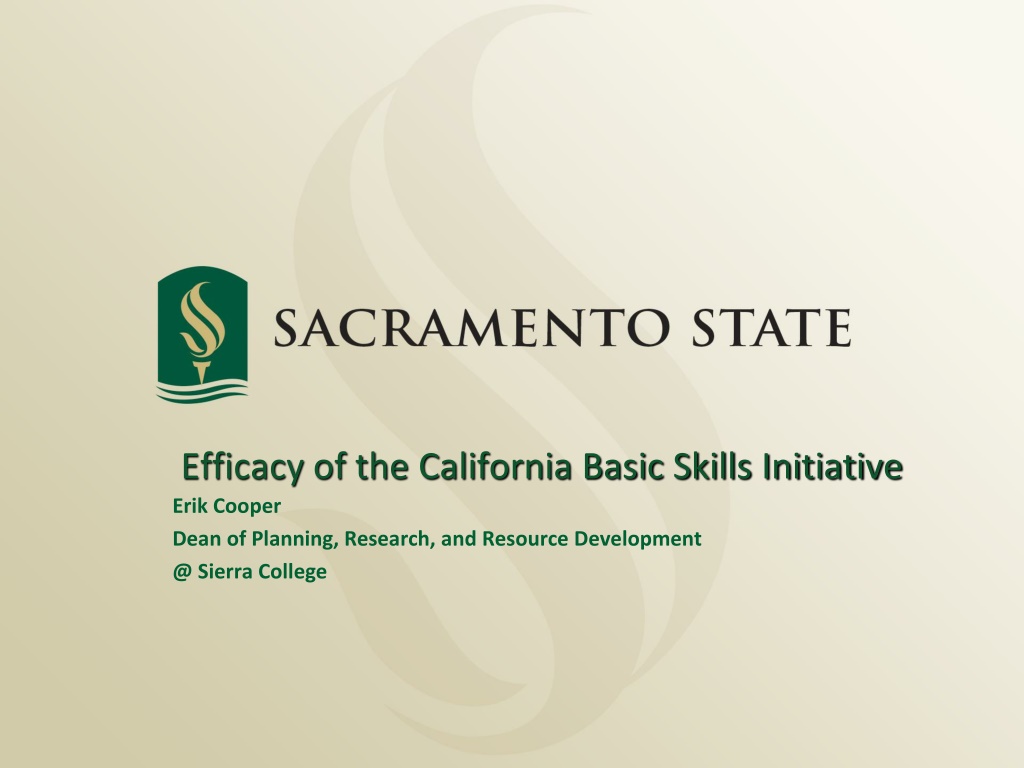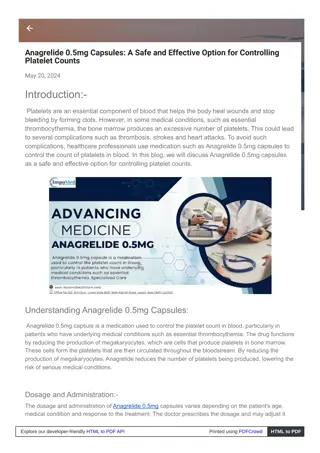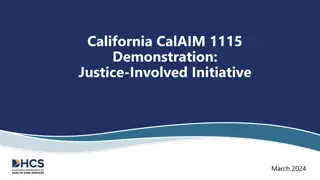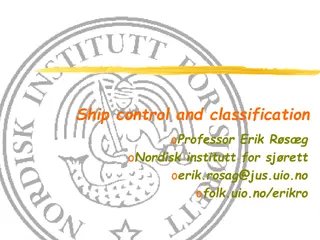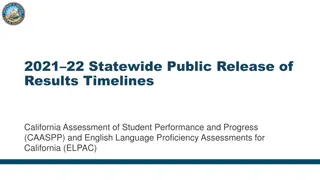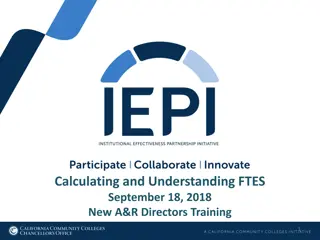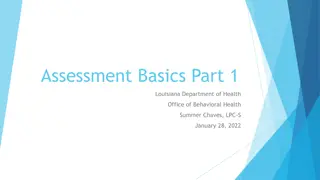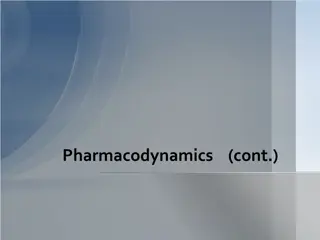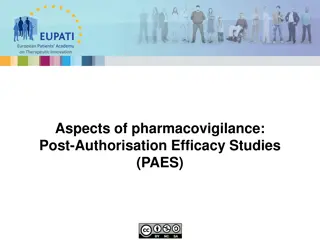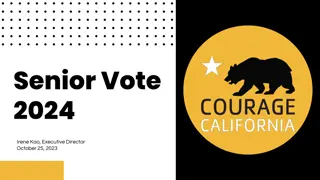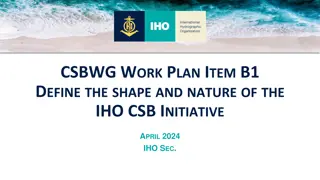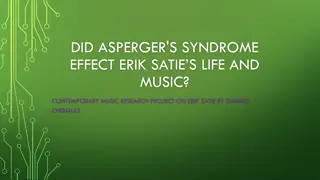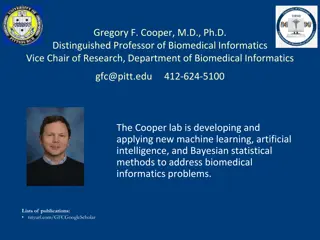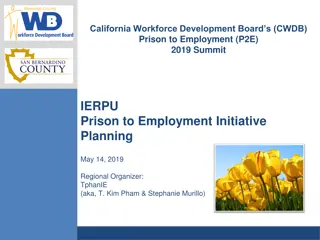Efficacy of the California Basic Skills Initiative by Erik Cooper
Detailed examination of the California Basic Skills Initiative led by Erik Cooper, highlighting the importance of basic skills in college success. The initiative focuses on foundational skills in reading, writing, math, and English as a Second Language, aiming to address the remediation needs of a significant percentage of California college students. Through research, methodology, and results, the effectiveness and components of the initiative are analyzed, emphasizing the critical role basic skills play in student achievement.
Uploaded on Sep 24, 2024 | 0 Views
Download Presentation

Please find below an Image/Link to download the presentation.
The content on the website is provided AS IS for your information and personal use only. It may not be sold, licensed, or shared on other websites without obtaining consent from the author. Download presentation by click this link. If you encounter any issues during the download, it is possible that the publisher has removed the file from their server.
E N D
Presentation Transcript
Efficacy of the California Basic Skills Initiative Erik Cooper Dean of Planning, Research, and Resource Development @ Sierra College
Efficacy of the California Basic Skills Initiative What are Basic Skills? Why should we be concerned about Basic Skills? What is the purpose the BSI?? How did the BSI work? What were its components? What affects student success? Research Questions Methodology Results Conclusion
Basic Skills Basic skills are those foundation skills in reading, writing, mathematics, and English as a Second Language, as well as learning skills and study skills, which are necessary for students to succeed in college-level work.
Scope California will need at least 1 million more college graduates by 2025(Johnson & Sengupta, 2009) Even more if you include AA & Certificates (Tierney & Hentschke, 2011; Lumina Foundation, 2013) CCCs serve 69% of California college students 11% CSU, 5% at UC (IPEDS, 2013) 43% of CSU & UC graduates are CCC transfers (CCCCO, 2012) Up to 70% of students need English remediation Up to 90% of students need math remediation (CCC Student Success Taskforce, 2012)
The Basic Skills Initiative (BSI) BSI (2007) Research Basic Skills as a Foundation for Student Success in California Community Colleges (Poppy Copy) Resources Per FTE funding; $100K min first 2 years, $90K subsequent years Support Websites Professional Development Grant 3CSN
Basic Skills as a Foundation Reviewed over 250 studies Visited 33 CCCs, 9 out of state colleges Results 26 recommendations 4 categories Organizational and Administrative Procedures Program Components Professional Development Instructional Practices
Alignment The developmental education program addresses holistic development of all aspects of the student. Attention is paid to the social and emotional development of the students as well as to their cognitive growth. design/delivery of courses in the developmental program. Sound principles of learning theory are applied in the Orientation, assessment, and placement are mandatory for all new students. Regular program evaluations are conducted, results are disseminated widely, and data are used to improve practice. A comprehensive system of support services exists, and is characterized by a high degree of integration among academic and student support services. A clearly articulated mission based on a shared, overarching philosophy drives the developmental education program. Clearly specified goals and objectives are established for developmental courses and programs. Socioeconomic Status Race/Ethnicity Parental Status
Problems One source found that only a quarter of students enrolling in a basic reading class ever enroll in transfer - level English, and only 10% of students enrolling in basic math end up in transferable math (Center for Student Success, 2005). But with the current state of knowledge and data, no one, absolutely no one, has any idea about which reasons are more important than others, and no one has the quantitative data that might enable a statistical analysis of which causes are more important. (Grubb & Gabriner, 2013)
Research Questions 1. Has the California Basic Skills Initiative had a positive impact on getting students through basic skills coursework to college-level coursework in mathematics and English composition? 2. Were there particular practices, as outlined in the Basic Skills as a Foundation for Student Success in California Community Colleges, which effectively improved student success in basic skills as defined in question 1? 3. Are there colleges that have been unidentified or unrepresented in the current literature that had unexpectedly high gains in improving student success in basic skills as defined in question 1?
Methodology: Question 1 Datasets CCCCO MIS Data Cohorts: 2-years to complete college level coursework Fall 2006, Fall 2007, Fall 2008, Fall 2009, Fall 2010 ~85,000/cohort English, ~78,000/cohort math CCCCO Data Mart College Demographics College enrollment US Census Bureau BSI Annual College Expenditure reports 2008, 2009, 2010
Methodology: Question 1 Survey College Practices Basic Skills as a Foundation for Student Success in the California Community Colleges (2007) Basic Skills Completion (2013) Electronic Survey January/February 2014 Linear Regression Dependent Variable: Percent improvement
Linear Regression y = 1.006x + 1.3681 Dependent Variable Dependent Variable Independent Variables Independent Variables
Methodology: Question 2 Two methods: Catalog significant practices from regression model Significant correlations with the improvement rate
Methodology: Question 3 Calculate the residuals for each college based on the linear regression models produced to answer question 1 Positive residuals = exceed prediction Negative residuals = fail to meet prediction
Residuals y = 1.006x + 1.3681 1.60 Dependent Variable -1.89 Independent Variables
Data 2 x 2 Subjects English Math Datasets 33 Survey Respondents 112 CCCs
Representativeness 33 Colleges 45 Survey respondents Removed repeats and unfinished surveys Representativeness ~29% of students in CCCs No significant demographic differences Regionally representative
Has the California Basic Skills Initiative had a positive impact on getting students through basic skills coursework to college level coursework in mathematics and English composition? 3.1% 2,705 33.97 32.34 31.94 31.77 30.87 % Successful 2.4% 1,967 21.09 19.77 19.50 19.45 18.69 BSI Begins Fall 2006 Fall 2007 Fall 2008 Fall 2009 Fall 2010 Math English CCC Students Successfully Completing College Level
English English33: Predictors of the Improvement Rate for Developmental English Statistically Significant Variables English112: Predictors of the Improvement Rate for Developmental English Statistically Significant Variables B B 2 year success rate for all 2006 cohort in developmental English Amount spent on articulation from the 2008 BSI allocation County median income -0.3850*** 2 year success rate for all 2006 cohort -0.2464*** Amount spent on articulation from the 2008 BSI allocation 0.0018*** 0.0006** 0.0004*** Proportion of students identifying as unknown -74.4433*** Percent of the 2008 BSI allocation spent on assessment 0.3240** Proportion of students identifying as American Indian Percent of 2008 BSI allocation spent on counseling or advising Percent of 2010 BSI allocation spent on program development 286.2584** Amount spent on articulation from the 2009 BSI allocation -0.0003* -0.1515** -0.1287* Amount spent on equipment and materials from the 2009 BSI allocation -0.0001* Percent of 2010 BSI allocation spent on articulation -1.8083** Residual articulation expenditure from the 2010 allocation Constant *p < .05, **p < .01, ***p < .001, n=33, R2=0.841 Proportion of students identifying as unknown 17.1533** -0.3030** -6.124 Constant *p < .05, **p < .01, ***p < .001, R2=0.342 13.9055
Mathematics Math112: Predictors of the Improvement Rate for Developmental Mathematics Statistically Significant Variables 2 year success rate for fall 2006 cohort in developmental math Proportion of students identifying as African American Proportion of students identifying as American Indian Math33: Predictors of the Improvement Rate for Developmental Math B Statistically Significant Variables B -0.7160*** 2 year success rate for fall 2006 cohort in developmental math -0.52360*** -29.7520** 847.1545*** Proportion of full-time students 34.99990** Proportion of basic-skills FTES -89.63959** Proportion of students identifying as Multi-ethnic 224.4912*** Proportion of students identifying as White -25.8580*** Level of developmental faculty involvement in professional development 2.89229* Proportion of full-time students 31.6386** Amount of expenditures (2010) per headcount 0.0336* Total program development expenditure ($) 2008- 2010 -0.00002* Amount spent on articulation from the 2010 BSI allocation Percent of 2010 BSI allocation spent on coordination County median income Constant *p < .05, **p < .01, ***p < .001, R2=0.652 0.0002** Total equipment and materials expenditure ($) 2008-2010 -0.1093* -0.00006* 0.0002** -6.40128 Constant *p < .05, **p < .01, ***p < .001, n=33, R2=0.677 4.26869
Were there particular practices, as outlined in the Basic Skills as a Foundation for Student Success in California Community Colleges, which effectively improved student success in basic skills as defined in question one? English33 Linear Regression None Correlation Counseling integrated into developmental coursework (R=0.369, p=0.035) Reading Apprenticeship (p=0.057) Mathematics33 Linear Regression Developmental Education Faculty involved in Professional Development Correlation None Degree to which colleges offer orientation (p=0.063) "We are not interested in the logic itself, nor will we argue for replacing the .05 alpha with another level of alpha, but at this point in our discussion we only wish to emphasize that dichotomous significance testing has no ontological basis. That is, we want to underscore that, surely, God loves the .06 nearly as much as the .05. Can there be any doubt that God views the strength of evidence for or against the null as a fairly continuous function of the magnitude of p?" - Rosnow, R.L. & Rosenthal, R. (1989).
Practices Please rate the degree to which your college has adopted the following curricular practices in developmental MATH courses: Please rate the degree to which your college has adopted the following curricular practices in developmental ENGLISH courses: Adopted permanently by FEW faculty Adopted permanently by SOME faculty Adopted permanently by MANY faculty Not adoptedConsidered, but not adopted it Piloted on a small scale Piloted on a large scale No Response Adopted permanently by FEW faculty 6% Adopted permanently by SOME faculty 15% Adopted permanently by MANY faculty 12% Not adoptedConsidered, but not adopted it Piloted on a small scale Piloted on a large scale No Response Accelerated Curriculum 18% 21% 15% 9% 3% Accelerated Curriculum Contextualized Instruction 21% 12% 15% 18% 24% 27% 0% 3% 9% 12% 12% 15% 9% 6% 9% 6% Contextualized Instruction First Year Experience Programs 21% 27% 21% 3% 9% 9% 0% 9% 18% 15% 30% 9% 3% 18% 0% 6% First Year Experience Programs Learning Communities 27% 9% 27% 6% 9% 12% 3% 6% 6% 6% 45% 3% 15% 18% 3% 3% Learning Communities Summer Bridge Programs 21% 9% 27% 6% 12% 15% 6% 3% 24% 18% 30% 0% 12% 6% 3% 6% Summer Bridge Programs "Flipped" Classrooms 12% 21% 45% 0% 3% 12% 3% 3% 36% 21% 18% 0% 9% 9% 0% 6% "Flipped" Classrooms Habits of Mind 27% 30% 27% 12% 21% 21% 3% 0% 12% 21% 3% 6% 3% 6% 3% 3% Habits of Mind Reading Apprenticeship 36% 24% 15% 0% 6% 9% 3% 6% 21% 12% 27% 3% 18% 9% 0% 9% Reading Apprenticeship 36% 30% 18% 3% 3% 3% 0% 6% Collaborative Collaborative Learning Learning 15% 9% 12% 9% 27% 15% 0% 0% 18% 24% 15% 18% 6% 18% 6% 6% Problem Based Problem Based Learning Learning 21% 24% 12% 30% 21% 6% 0% 0% 18% 15% 15% 15% 6% 3% 6% 6%
Expenditures English Linear Regression English33 Amount spent on articulation from the 2008 BSI allocation Percent of 2008 BSI allocation spent on counseling or advising Percent of 2010 BSI allocation spent on program development Percent of 2010 BSI allocation spent on articulation Residual articulation expenditure from the 2010 allocation English112 Amount spent on articulation from the 2008 BSI allocation Percent of the 2008 BSI allocation spent on assessment Amount spent on articulation from the 2009 BSI allocation Amount spent on equipment and materials from the 2009 BSI allocation Correlation English112 Amount spent on articulation from the 2008 BSI allocation (R=0.216, p=0.023) Proportion spent on articulation from the 2008 allocation(R=0.235, p=.013) Proportion spent on assessment in 2008 (R=0.228, p=.016) Proportion spent on advising in 2009 (R=0.248, p=0.009) Proportion spent on advising in 2010 (R=0.241, p=0.011) Amount spent on equipment and materials from the 2009 BSI allocation (R=-0.207, p=0.029) Amount spent on coordination from the 2009 BSI allocation (R=-0.0206, p=0.030)
Expenditures Mathematics Linear Regression Math33 Total program development expenditure ($) 2008-2010 Total equipment and materials expenditure ($) 2008-2010 Math112 Amount of expenditures (2010) per headcount Amount spent on articulation from the 2010 BSI allocation Percent of 2010 BSI allocation spent on coordination Correlation Math112 Expenditure per Basic Skills Credit FTES (R=-0.235, p=0.013)
Are there colleges that have been unidentified or unrepresented in the current literature that had unexpectedly high gains in improving student success in basic skills as defined in question one? Five colleges with the highest residuals for the mathematics improvement rate of responding colleges Five colleges with the highest residuals for the English improvement rate of responding colleges College Woodland Los Angeles City College Residual 6.32 6.12 College Residual Berkeley City Modesto Junior College Cypress Los Angeles Pierce 7.27 6.17 5.97 5.06 Modesto Junior College 5.67 Citrus Las Positas 2.7 2.66 Allan Hancock 5.02 Five colleges with the highest residuals for the mathematics improvement rate Five colleges with the highest residuals for the English improvement rate College American River Citrus Monterey Peninsula Canada Los Medanos Residual 19.86 16.26 14.25 13.48 13.03 College Los Angeles Harbor 14.38 Victor Valley Los Angeles Pierce Monterey Peninsula 12.42 Modesto Junior College Residual 13.38 13.2 11.06
Limitations 2-year time scale Student Success Underrepresented groups Survey Questions Simplistic interpretation of practices Rate versus Volume
Limitations Survey Response Rate 33/112 colleges ~30% No significant differences in any variables Geographic representation Survey methodology 3 contacts CCCCO maintained list 25-60% response rate in literature (Greenlaw & Brown-Welty, 2009; Lefever, Dal, & Matthiasdottir, 2007; Nulty, 2008; Walt, Atwood, & Mann, 2008) Confidence Interval +/- 5% is 87 colleges
Future Directions Student Success and Support Program (SSSP) Integrated Counseling (English) Improved Assessment (Math) Pedagogy/Andragogy Acceleration (English) Requires coordination Flipped Classroom (Math) Individual Faculty Professional Development Developmental faculty involved (Math)
Future Directions Coding Colleges should review coding of non-sequence courses Reporting & Evaluation Greater intentionality in reporting requirements CCCCO is well positioned for research Using existing tools has already produced useful data Basic Skills Completion
Has the California Basic Skills Initiative had a positive impact on getting students through basic skills coursework to college level coursework in mathematics and English composition? Yes, but Modest improvement Need greater investment in student services Need pedagogical reform Low practice adoption Need clear goals and expectations Need to better assess progress Need better support across colleges similar to what student success looks like
Were there particular practices, as outlined in the Basic Skills as a Foundation for Student Success in California Community Colleges, which effectively improved student success in basic skills as defined in question one? Maybe. Integrated Counseling (English) Improved Assessment (Math) Acceleration (English) Flipped Classroom (Math) Developmental faculty involved in professional development (Math)
Are there colleges that have been unidentified or unrepresented in the current literature that had unexpectedly high gains in improving student success in basic skills as defined in question one? Yes. At a minimum 1. Citrus College* 2. Los Angeles Pierce 3. Modesto Junior
Efficacy of the California Basic Skills Initiative Erik Cooper
